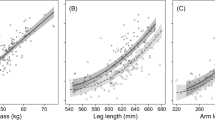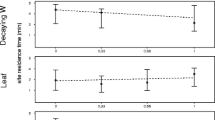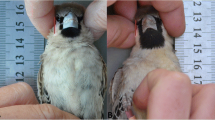Abstract
The influence of individual factors on dominance rank and the relationship between rank distance and patterns of aggression predicted by models of evolutionarily stable strategies (ESS) of animal conflict were investigated in a managed bachelor group of Sorraia horses, Equus caballus. The group was composed of four to six stallions 3- to 12-years-old during the study period. The dominance hierarchy was significantly linear and rank was not related to age, weight, height or aggressiveness. Frequency and intensity of agonistic interactions were low, but higher-ranking stallions did not receive lower aggressiveness than lower-ranking stallions. There was some evidence that dominance relationships were more contested among close-ranking stallions, as predicted. Agonistic-related interactions among close-ranking stallions served similar functions to those among distant-ranking stallions, but the latter interacted more frequently than expected for access to resting sites and/or resting partners. Therefore, we found some evidence that agonistic-related interactions among distant-ranking stallions play a larger role in providing access to valuable and defendable resources than those among close-ranking stallions. Nevertheless, the fact that space to escape from aggression was limited and breeding access was independent from dominance rank may have reduced the benefits relative to costs of aggression and therefore limited the occurrence of contests over dominance and resources.
Similar content being viewed by others
References
Altmann J (1974) Observational study of behavior: sampling methods. Behaviour 49:227–265. doi:10.1163/156853974X00534
Appleby MC (1983a) The probability of linearity in hierarchies. Anim Behav 31:600–608. doi:10.1016/S0003-3472(83)80084-0
Appleby MC (1983b) Competition in a red deer stag social group: rank, age and relatedness of opponents. Anim Behav 31:913–918. doi:10.1016/S0003-3472(83)80246-2
Arnold GW, Grassia A (1982) Ethogram of agonistic behaviour for thoroughbred horses. Appl Anim Ethol 8:5–25. doi:10.1016/0304-3762(82)90129-8
Asa CS (1999) Male reproductive success in free-ranging feral horses. Behav Ecol Sociobiol 47:89–93. doi:10.1007/s002650050653
Berger J (1986) Wild horses of the Great Basin. University of Chicago Press, Chicago
Boyd LE (1991) The behavior of Przewalski’s horses and its importance to their management. Appl Anim Behav Sci 29:301–318. doi:10.1016/0168-1591(91)90256-W
Boyd L, Houpt KA (1994) Przewalski’s horse: the history and biology of an endangered species. State University of New York Press, Albany
Chase ID, Bartolomeo C, Dugatkin LA (1994) Aggressive interactions and inter-contest interval: how long do winners keep winning? Anim Behav 48:393–400. doi:10.1006/anbe.1994.1253
Christensen JW, Zharkikh T, Ladewig J, Yasinetskaya N (2002) Social behaviour in stallion groups (Equus przewalskii and Equus caballus) kept under natural and domestic conditions. Appl Anim Behav Sci 76:11–20. doi:10.1016/S0168-1591(01)00208-8
Clutton-Brock TH, Greenwood PJ, Powell RP (1976) Ranks and relationships in Highland ponies and Highland cows. Z Tierpsychol 41:202–216
De Vries H (1995) An improved test of linearity in dominance hierarchies containing unknown or tied relationships. Anim Behav 50:1375–1389. doi:10.1016/0003-3472(95)80053-0
De Vries H (1998) Finding a dominance order most consistent with a linear hierarchy: a new procedure and review. Anim Behav 55:827–843. doi:10.1006/anbe.1997.0708
Estabrook GF, Almada VC, Almada FJ, Robalo JI (2002) Analysis of conditional contingency using ACTUS2 with examples from studies of animal behavior. Acta Ethol 4:73–80. doi:10.1007/s102110100050
Feh C (1988) Social behaviour and relationships of Przewalski horses in Dutch semi-reserves. Appl Anim Behav Sci 21:71–87. doi:10.1016/0168-1591(88)90101-3
Feist JD, McCullough DR (1976) Behavior patterns and communication in feral horses. Z Tierpsychol 41:337–371
Heitor F, Oom MM, Vicente L (2006) Social relationships in a herd of Sorraia horses: part I. Correlates of social dominance and contexts of aggression. Behav Process 73:170–177. doi:10.1016/j.beproc.2006.05.004
Hemelrijk CK (1990) Models of, and tests for, reciprocity, unidirectionality and other social interaction patterns at a group level. Anim Behav 39:1013–1029. doi:10.1016/S0003-3472(05)80775-4
Hoffmann R (1985) On the development of social behaviour in immature males of a feral horse population (Equus przewalskii f. caballus). Z Säugetierkd 50:302–314
Houpt KA, Keiper R (1982) The position of the stallion in the equine dominance hierarchy of feral and domestic ponies. J Anim Sci 54:945–950
Houpt KA, Law K, Martinisi V (1978) Dominance hierarchies in domestic horses. Appl Anim Ethol 4:273–283. doi:10.1016/0304-3762(78)90117-7
Johnson JA (1989) Supplanting by olive baboons: dominance rank distance and resource value. Behav Ecol Sociobiol 24:277–283. doi:10.1007/BF00290903
Kaseda Y, Ogawa H, Khalil AM (1997) Causes of natal dispersal and emigration and their effects on harem formation in Misaki feral horses. Equine Vet J 29:262–266
Kaufmann JH (1983) On the definitions and functions of dominance and territoriality. Biol Rev 58:1–20
Keiper RR, Receveur H (1992) Social interactions of free-ranging Przewalski horses in semi-reserves in the Netherlands. Appl Anim Behav Sci 33:303–318. doi:10.1016/S0168-1591(05)80068-1
Keiper RR, Sambraus HH (1986) The stability of equine dominance hierarchies and the effects of kinship, proximity and foaling status on hierarchy rank. Appl Anim Behav Sci 18:121–130. doi:10.1016/0168-1591(86)90104-8
Khalil AM, Kaseda Y (1997) Behavioral patterns and proximate reason of young male separation in Misaki feral horses. Appl Anim Behav Sci 54:281–289. doi:10.1016/S0168-1591(97)00004-X
Khalil AM, Kaseda Y (1998) Early experience affects developmental behaviour and timing of harem formation in Misaki horses. Appl Anim Behav Sci 59:253–263. doi:10.1016/S0168-1591(98)00111-7
Kitchen DM, Cheney DL, Seyfarth RM (2005) Contextual factors mediating contests between male chacma baboons in Botswana: effects of food, friends and females. Int J Primatol 26:105–125. doi:10.1007/s10764-005-0725-y
Klingel H (1975) Social organization and reproduction in equids. J Reprod Fert 23(Suppl):7–11
Linklater WL, Cameron EZ, Minot EO, Stafford KJ (1999) Stallion harassment and the mating system of horses. Anim Behav 58:295–306. doi:10.1006/anbe.1999.1155
Luís C (2006) The Sorraia horse, a case study of a small and closed population. Contribution of molecular markers to the genetic conservation and management of an endangered breed. PhD Thesis, University of Lisbon, Portugal
Matsumura S, Kobayashi T (1998) A game model for dominance relations among group-living animals. Behav Ecol Sociobiol 42:77–84. doi:10.1007/s002650050414
Maynard Smith J, Parker GA (1976) The logic of asymmetric contests. Anim Behav 24:159–175. doi:10.1016/S0003-3472(76)80110-8
McDonnell SM, Haviland JCS (1995) Agonistic ethogram of the equid bachelor band. Appl Anim Behav Sci 43:147–188. doi:10.1016/0168-1591(94)00550-X
McDonnell SM, Murray SC (1995) Bachelor and harem stallion behavior and endocrinology. Biol Reprod Monogr 1:577–590
Miller R (1981) Male aggression, dominance and breeding behavior in Red Desert feral horses. Z Tierpsychol 57:340–351
Monard AM, Duncan P (1996) Consequences of natal dispersal in female horses. Anim Behav 52:565–579. doi:10.1006/anbe.1996.0198
Richards SM (1974) The concept of dominance and methods of assessment. Anim Behav 22:914–930. doi:10.1016/0003-3472(74)90015-3
Rutberg AT, Greenberg SA (1990) Dominance, aggression frequencies and modes of aggressive competition in feral pony mares. Anim Behav 40:322–331. doi:10.1016/S0003-3472(05)80927-3
Salter RE, Hudson RJ (1982) Social organization of feral horses in Western Canada. Appl Anim Ethol 8:207–223. doi:10.1016/0304-3762(82)90205-X
Scherf BD (2000) World watch list for domestic animal diversity, 3rd edn. FAO, Rome
Schilder MBH (1988) Dominance relationships between adult plains zebra stallions in semi-captivity. Behaviour 104:300–319. doi:10.1163/156853988X00566
Tilson RL, Sweeny KA, Binczik GA, Reindl NJ (1988) Buddies and bullies: social structure of a bachelor group of Przewalski horses. Appl Anim Behav Sci 21:169–185. doi:10.1016/0168-1591(88)90106-2
Trivers RL (1972) Parental investment and sexual selection. In: Campbell B (ed) Sexual selection and the descent of man. Aldine, Chicago, pp 136–179
Tyler S (1972) The behaviour and social organization of the New Forest ponies. Anim Behav Monogr 5:85–196
Van Dierendonck MC, De Vries H, Schilder MBH (1995) An analysis of dominance, its behavioural parameters and possible determinants in a herd of Icelandic horses in captivity. Neth J Zool 45:362–385. doi:10.1163/156854295X00366
Van Doorn GS, Hengeveld GM, Weissing FJ (2003a) The evolution of social dominance I: two-player models. Behaviour 140:1305–1332. doi:10.1163/156853903771980602
Van Doorn GS, Hengeveld GM, Weissing FJ (2003b) The evolution of social dominance II: multi-player models. Behaviour 140:1333–1358. doi:10.1163/156853903771980611
Vervaecke H, Stevens JMG, Vandemoortele H, Sigurjónsdóttir H, De Vries H (2007) Aggression and dominance in matched groups of subadult Icelandic horses (Equus caballus). J Ethol 25:239–248. doi:10.1007/s10164-006-0019-7
Weeks JW, Crowell-Davis SL, Caudle AB, Heusner GL (2000) Aggression and social spacing in light horse (Equus caballus) mares and foals. Appl Anim Behav Sci 68:319–337. doi:10.1016/S0168-1591(99)00126-4
Wells SM, Von Goldschmidt-Rothschild B (1979) Social behaviour and relationships in a herd of Camargue horses. Z Tierpsychol 49:363–380
Acknowledgments
We thank José Luís Sommer d’Andrade for permission to conduct this study at Fontalva Estate, for information provided about the horses and their management, and for assistance in measuring body weight. We are also indebted to Dr. Charlotte Hemelrijk and Dr. George Estabrook for providing their computer programs. F.H. was supported by a Doctoral Fellowship granted by the Fundação para a Ciência e a Tecnologia (SFRH/BD/8792/2002).
Author information
Authors and Affiliations
Corresponding author
About this article
Cite this article
Heitor, F., Vicente, L. Dominance relationships and patterns of aggression in a bachelor group of Sorraia horses (Equus caballus). J Ethol 28, 35–44 (2010). https://doi.org/10.1007/s10164-009-0152-1
Received:
Accepted:
Published:
Issue Date:
DOI: https://doi.org/10.1007/s10164-009-0152-1




